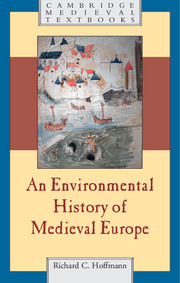Book contents
- Frontmatter
- Contents
- List of figures
- List of maps
- Preface
- Frontispiece: Nature and culture at Waterford, Ireland, 1372
- Introduction: Thinking about medieval Europeans in their natural world
- 1 Long no wilderness
- 2 Intersecting instabilities: culture and nature at medieval beginnings, c.400–900
- 3 Humankind and God’s Creation in medieval minds
- 4 Medieval land use and the formation of traditional European landscapes
- 5 Medieval use, management, and sustainability of local ecosystems, 1: primary biological production sectors
- 6 Medieval Use, management, and sustainability of local ecosystems, 2: interactions with the non-living environment
- 7 ‘This belongs to me . . .’
- 8 Suffering the uncomprehended: disease as a natural agent
- 9 An inconstant planet, seen and unseen, under foot and overhead
- 10 A slow end of medieval environmental relations
- Afterword
- A sampler for further reading
- Index
- References
7 - ‘This belongs to me . . .’
Published online by Cambridge University Press: 05 July 2014
- Frontmatter
- Contents
- List of figures
- List of maps
- Preface
- Frontispiece: Nature and culture at Waterford, Ireland, 1372
- Introduction: Thinking about medieval Europeans in their natural world
- 1 Long no wilderness
- 2 Intersecting instabilities: culture and nature at medieval beginnings, c.400–900
- 3 Humankind and God’s Creation in medieval minds
- 4 Medieval land use and the formation of traditional European landscapes
- 5 Medieval use, management, and sustainability of local ecosystems, 1: primary biological production sectors
- 6 Medieval Use, management, and sustainability of local ecosystems, 2: interactions with the non-living environment
- 7 ‘This belongs to me . . .’
- 8 Suffering the uncomprehended: disease as a natural agent
- 9 An inconstant planet, seen and unseen, under foot and overhead
- 10 A slow end of medieval environmental relations
- Afterword
- A sampler for further reading
- Index
- References
Summary
Medieval Europeans applied their ecological knowledge and technical know-how within socio-cultural rules which identified who could decide what of the natural world was to be used, when, and in what way. These were customary and legal determinations of relations among people rather than religious or philosophical understandings of relations between nature and humankind. As prototypical medieval canon lawyer Gratian acknowledged in his mid-twelfth-century Decretum, while divinely ordained natural law gave humankind all things in common, ‘by the law of custom or statute, this belongs to me, that belongs to someone else’. Property rights encompass the ownership, possession, usufruct, and acknowledged limits to uses of natural resources. They necessarily have social and environmental implications. Of course, the history of property rights and of the authority of the state contains much without direct bearing on human relations with the natural world, so this chapter will try to stay with those aspects which are or are said to be prime determinates of human decisions and impacts on natural resource use.
For present-day environmentalists, economists, and resource managers, the framing discourse linking property rights to problems of stewardship, overexploitation, depletion, and sustainability derives notably from a 1968 essay, ‘The Tragedy of the Commons’, which American ecologist Garret Hardin published in the influential journal Science. Hardin there argued that individual users of a common resource will each necessarily pursue his or her economic self-interest to the point that, collectively, they would deplete and destroy the resource itself. His prime illustrative example was a stereotype of a medieval village common pasture, where, said Hardin, each farmer kept adding additional livestock at no cost to himself but increasing pressure against the whole until the forage was eaten up. Hardin’s hypothetical case has subsequently justified especially the privatization of common resources – on grounds that individual private owners take more foresightful care of them – and occasionally the imposition of strict governmental controls over use of common goods. Both late twentieth-century creation of private ownership in regional water supply systems and in some ocean fisheries and growing government restrictions on pesticide use, waste disposal, and carbon emissions rested in part on this way of thinking. Its precursors rationalized eighteenth- and nineteenth-century destruction of European resource commons in the name of economic liberalism.
- Type
- Chapter
- Information
- An Environmental History of Medieval Europe , pp. 241 - 278Publisher: Cambridge University PressPrint publication year: 2014

